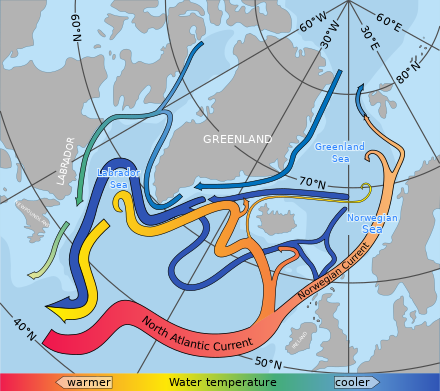The Norwegian Current (also known as the Norway Coastal Current) is one of two dominant arctic inflows of water. It can be traced from near Shetland, north of Scotland, otherwise from the eastern North Sea at depths of up to 100 metres. It finally passes the opening into the Barents Sea, a large outcrop of the Arctic Ocean. Compared to its partial source the North Atlantic Current (which otherwise loops into the East Greenland Current) it is colder and less salty; the other sources are the less saline North and Baltic seas and the Norwegian fjords and rivers. It is considerably warmer and saltier than the Arctic Ocean, which is freshened by precipitation and ice in and around it. Winter temperatures in the flow are typically between 2 and 5 °C — the co-parent North Atlantic flow, a heat remnant of its Gulf Stream chief contributor, exceeds 6 °C.
Norwegian coastal waters are dominated by two main water masses, water from the Norwegian Coastal Current and water from the North Atlantic Drift (Atlantic water). As the Norwegian Coastal Current moves northward, water from the North Atlantic Drift is mixed in, raising the salinity (see § Salinity).
The current is both wind-driven, "piling up" of water along the Norwegian coast by southwesterly winds (creating elevation and thus pressure differences), and also driven by its salinity distribution which in turn creates density gradients.[1]

- ^ Sætre, Roald, ed. 2007. The Norwegian Coastal Current—Oceanography and Climate. Tapir Academic Press; Trondheim. ISBN 82-519-2184-8